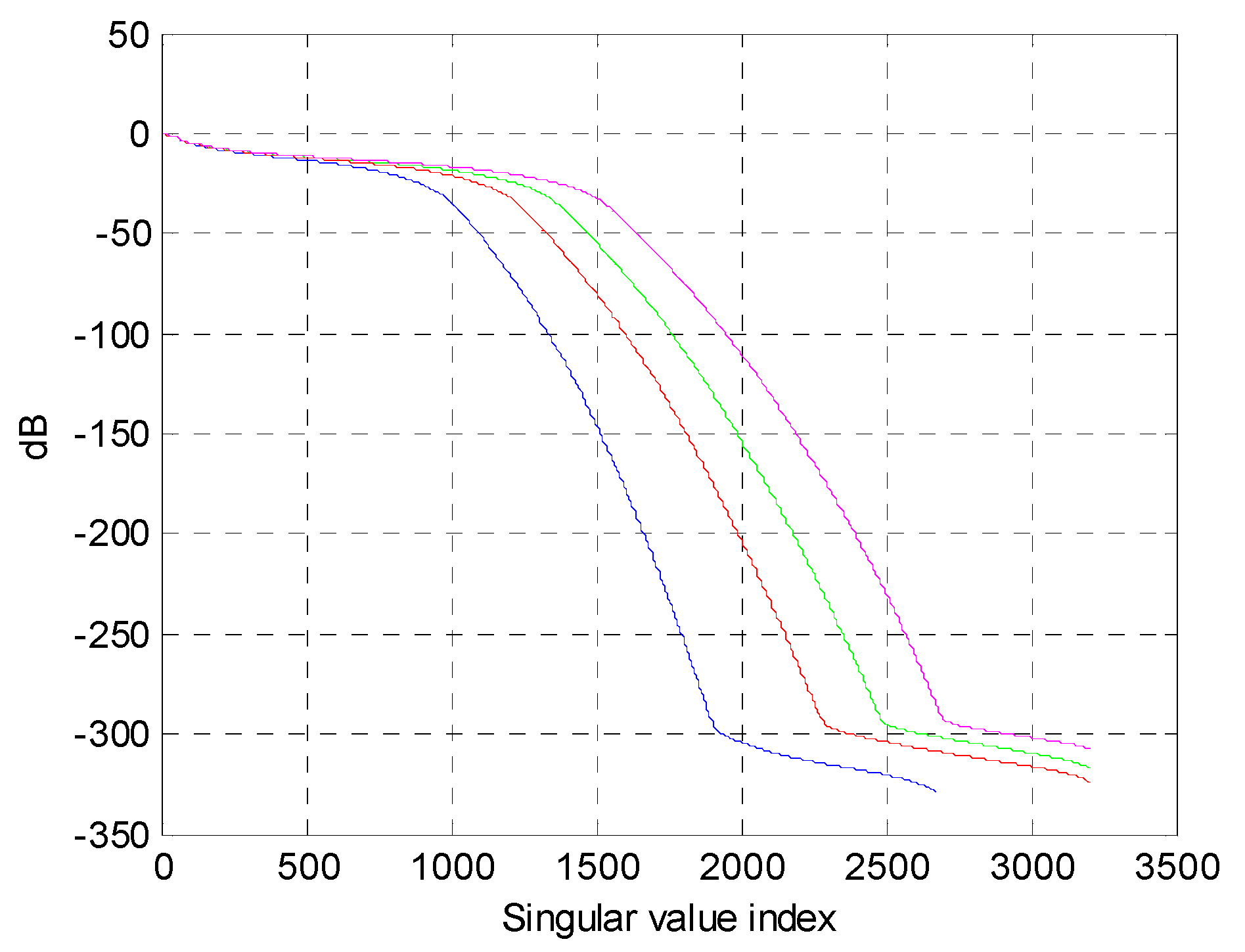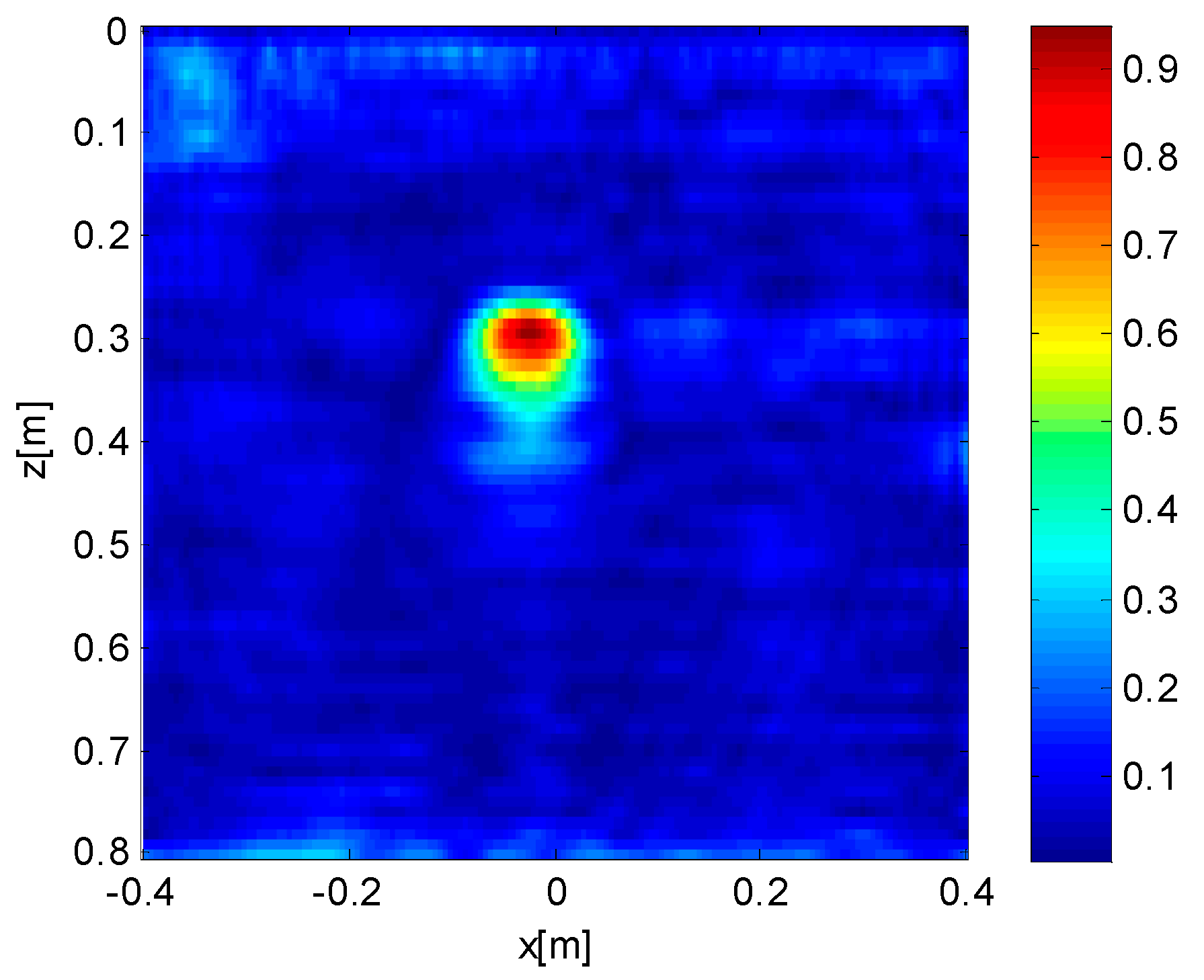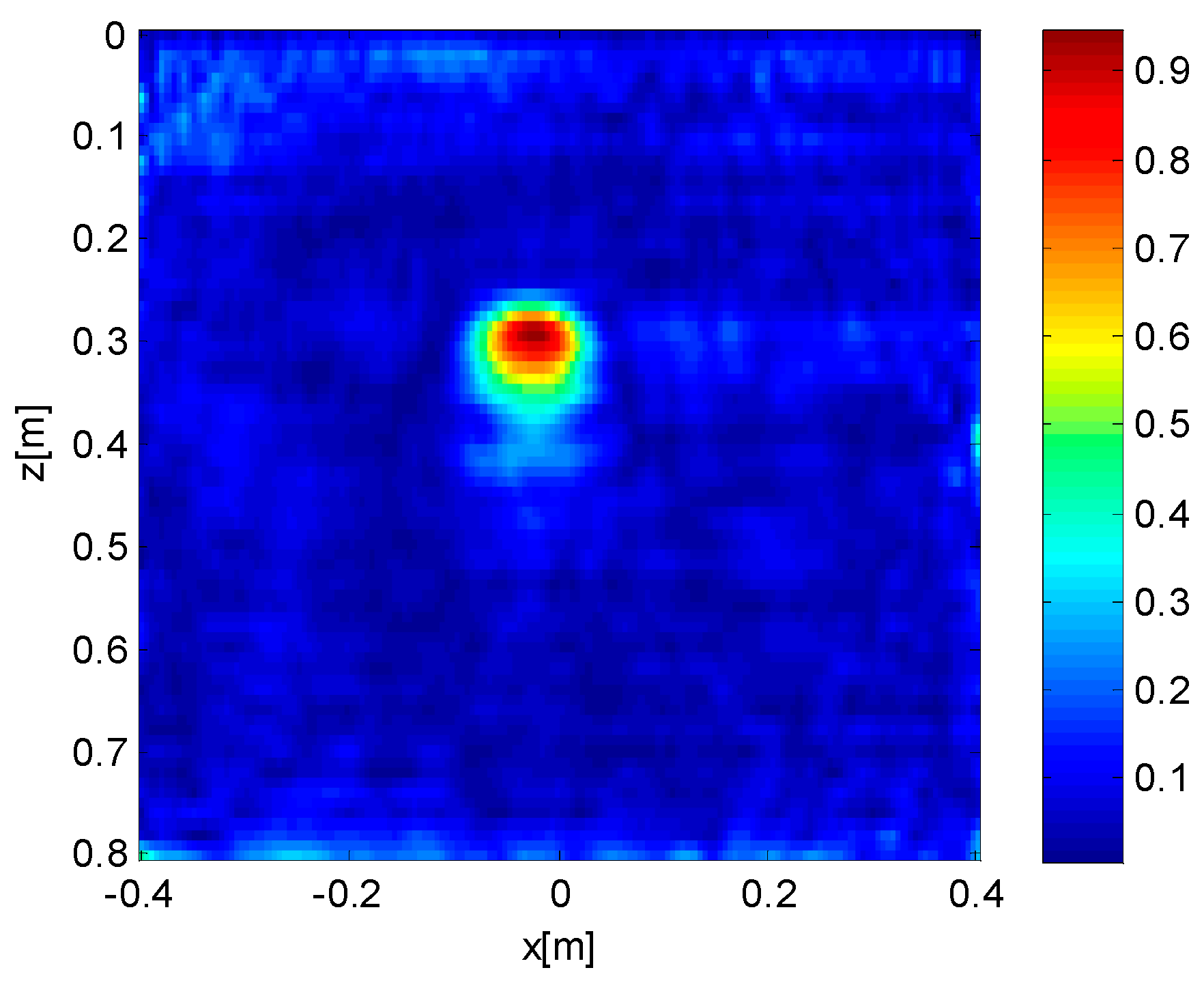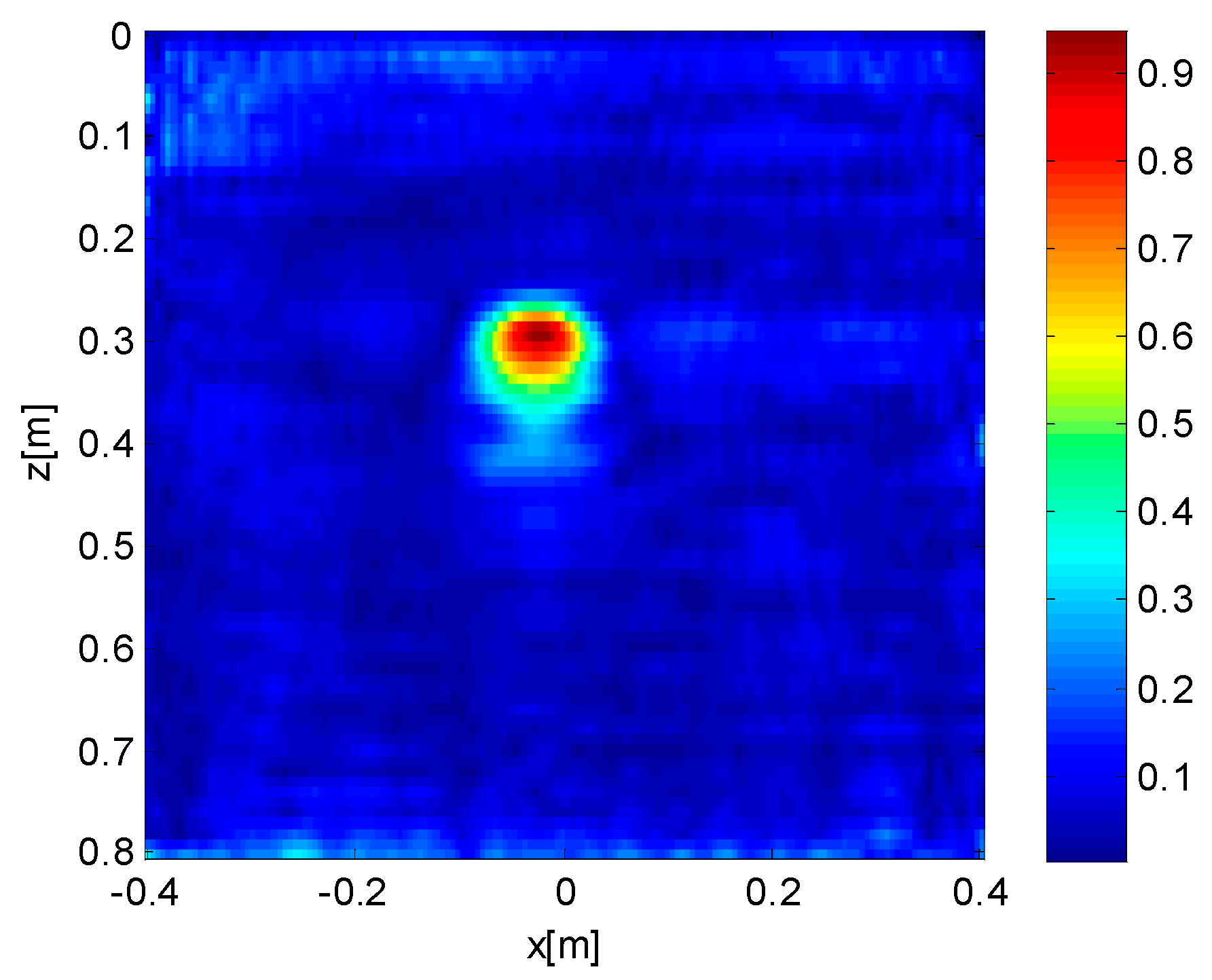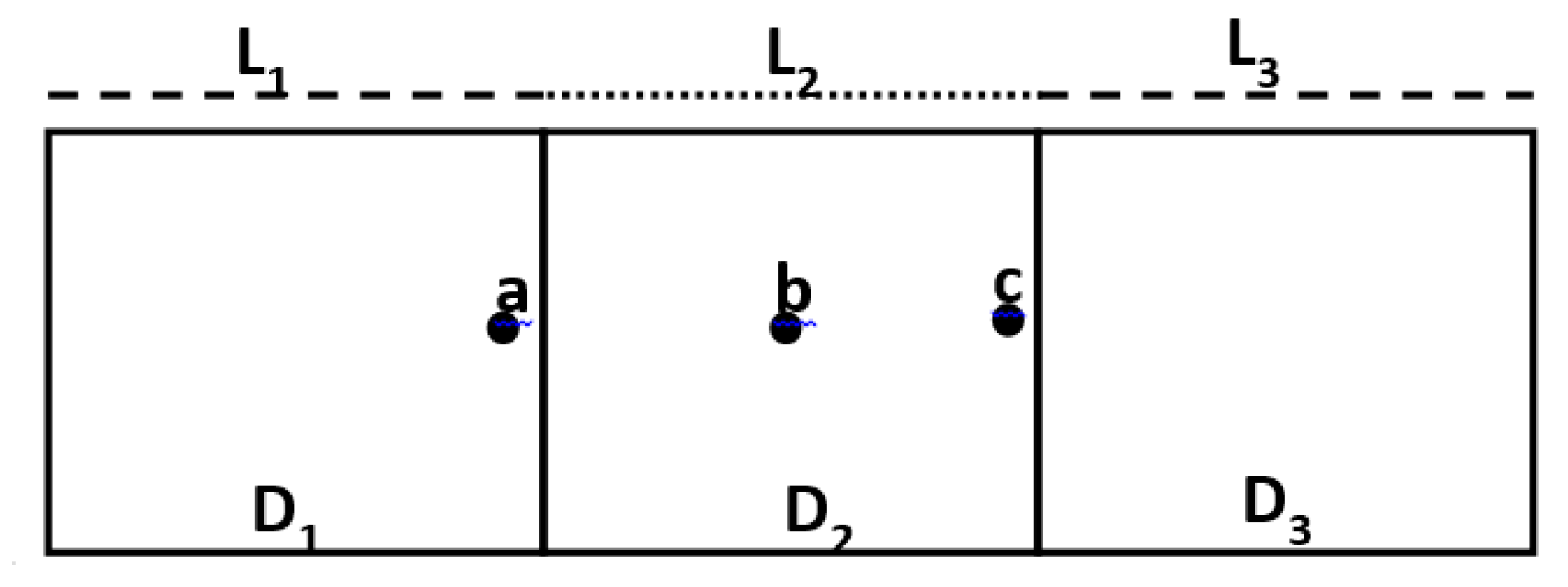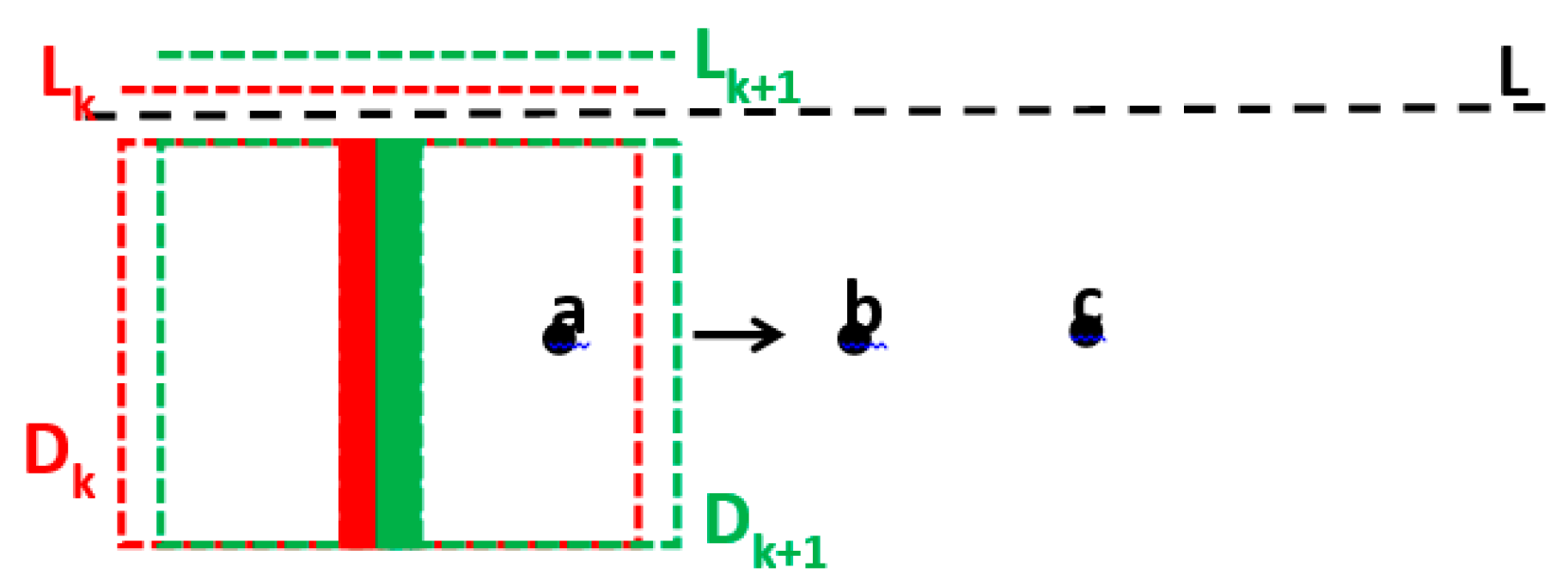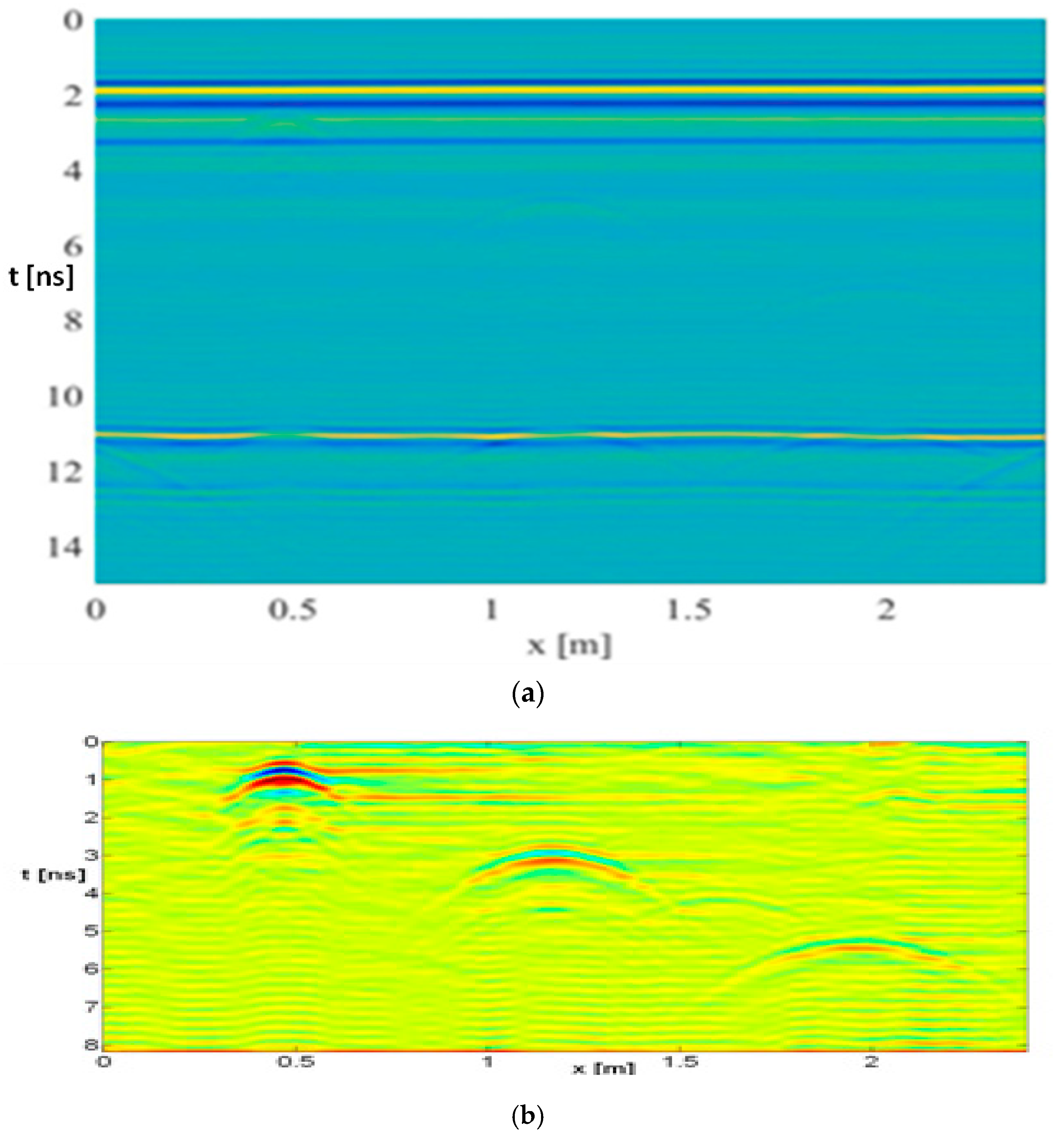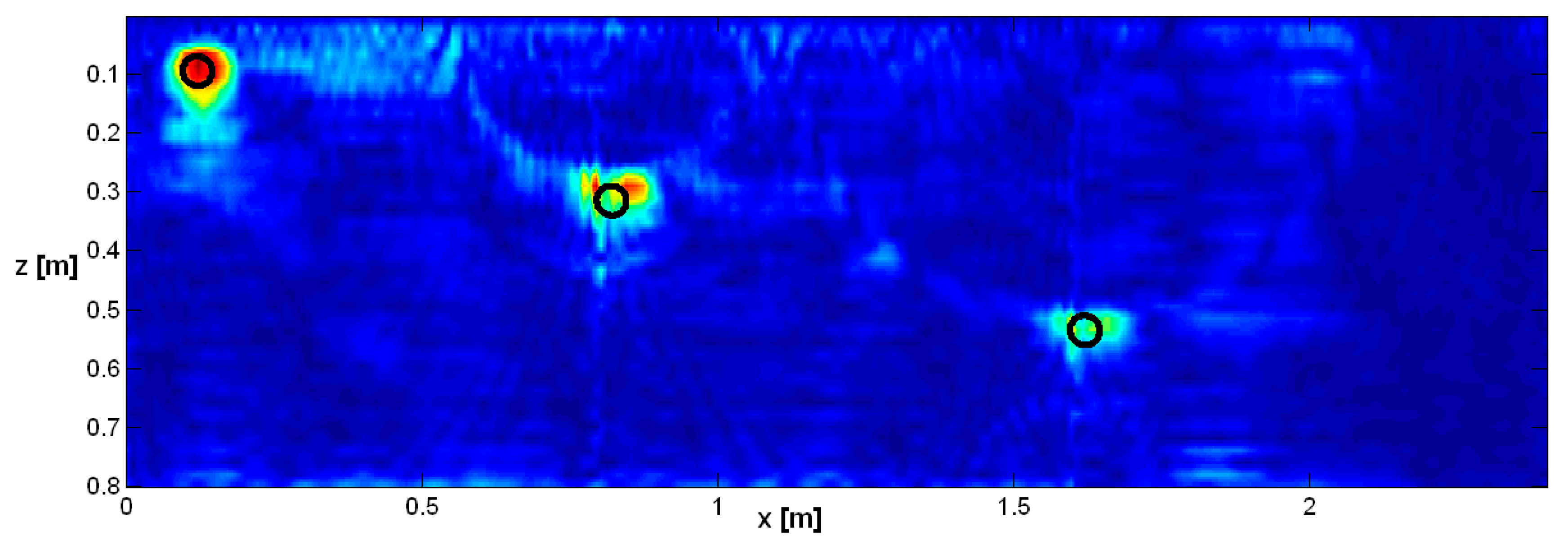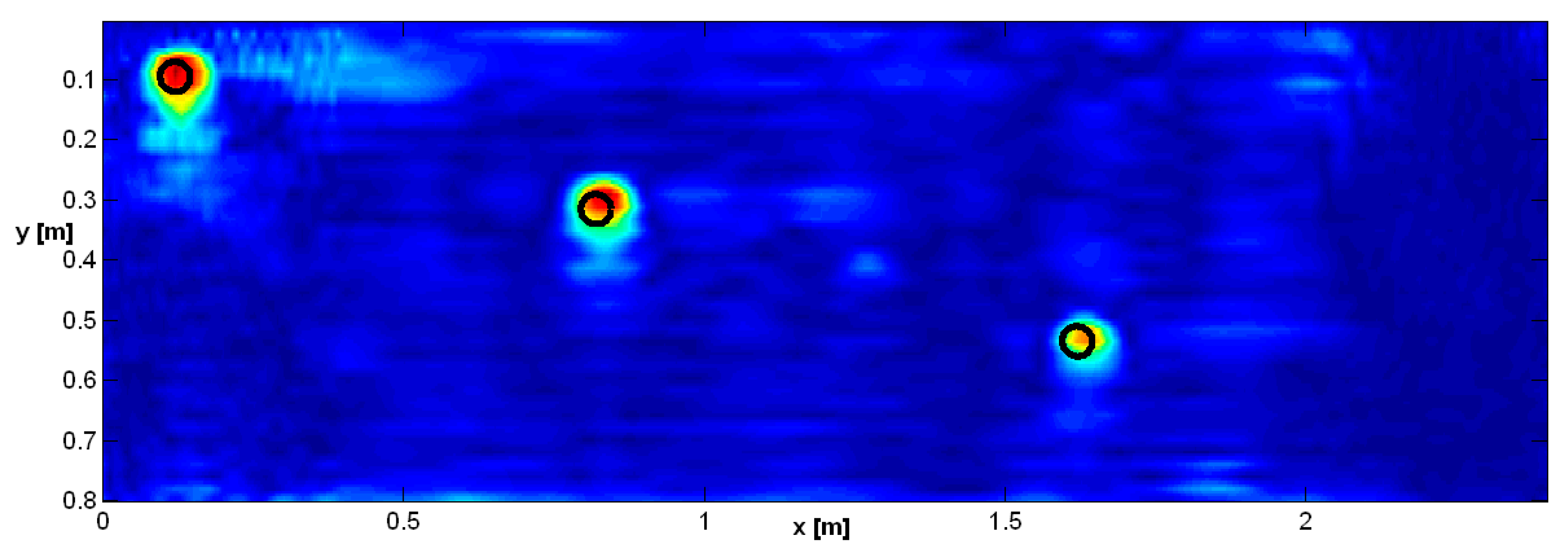1. Introduction
The classical way to achieve reliable and well-focused ground-penetrating radar (GPR) images is based on the migration procedure widely used and implemented in most available codes [
1,
2]. This data processing method originates from seismology [
3,
4,
5], and was later also adapted for the solution of inverse problems in Maxwell′s equations [
6,
7].
Another class of reconstruction approaches, also deployed in real world applications, exploits linear models of electromagnetic scattering [
6]. Either way, the adoption of linear models entails few limitations with regards to the possibility of dealing with mutual interactions between targets [
8] and reconstructing the electromagnetic properties of a target in a quantitative way [
9]. On the other hand, the Born Approximation method can be extended to a quadratic approximation, which permits mitigation of the effect of non-linearity, in terms of false solution occurrences [
10]. The reliability of the inverse scattering approach based on quadratic approximation has been also validated with data collected in the laboratory [
11].
Relative to non-linear methods, linear models allow reliable algorithms, based on the minimization of a cost function, which are not affected by the false solutions issue [
10,
11,
12]. The stability of the inversion approach is ensured by the exploitation of regularization schemes. Linear electromagnetic scattering inversion algorithms have been developed and analyzed in relation to their effectiveness with GPR problems and other electromagnetic geo-sounding techniques [
13,
14,
15,
16,
17]. In addition, linear inverse scattering models have applications in other, non-conventional configurations, such as the “differential ones” [
18,
19] and for radar on airborne vehicles [
20] and UAV [
21].
Relative to migration algorithms, a linear inverse scattering approach is able to account, in a rigorous way, for different issues, such as the presence of targets in the near field of the GPR system, truncation of the measurement domain and possible losses in the soil (often ignored in a migration algorithm, or rather counteracted with the application of some gain variable vs. depth). On the other hand, the linear inverse scattering approach requires filling and performing the inversion (in a generalized and regularized sense) of the matrix—which is the discretized version of the linear integral scattering operator—and this can be computationally demanding. The most popular approaches for regularizing a linear inversion are the Truncated Singular Value Decomposition (TSVD) [
22,
23,
24,
25] and the Tikhonov method [
26]. In this paper, we adopt a TSVD scheme, which permits, relative to migration, a more rigorous analysis of the performance of the inversion approach, in terms of its resolution limits. However, as previously mentioned, it has the main drawback of being much more demanding in terms of computational cost. Consequently, in real GPR surveys (with scanning lines of several tens or even hundreds of wavelengths long), it is not possible to compute SVD for the relatively large matrices involved. This, in general, prevents the possibility of “inverting” an entire radar image in a single step. The first strategy introduced to counteract this issue was to subdivide the overall scan profile into adjacent sub-profiles, sufficiently small enough to allow for the inversion of the matrix, and then, to join the inversion results achieved for each sub-profile side-by-side [
27,
28]. However, this approach poses several problems (described in detail in
Section 4) with regards to the targets located in the proximity of the lateral edges of two adjacent sub-profiles, or those that cross these lateral edges. A strategy aimed at mitigating these issues was presented in [
29], where a double sequence of investigation domains was exploited with a shift of half an investigation domain between two successive sub-profiles. In this paper, we propose an extension of that method, referred to as a shifting zoom, aimed at mitigating the problem of the reduction in size of the investigation domain which is needed to perform a sequential linear inversion. The method is validated by processing radar data collected in laboratory conditions over a sand box with three pipes buried at different depths.
The paper is organized as follows: in the next section, we provide the mathematical formulation for the inverse scattering problem. Then, a numerical analysis of the effect of prolongation of the observation line in the parity of the investigation domain is proposed in
Section 3. In
Section 4, we present the proposed shifting zoom procedure. In
Section 5 its effectiveness is shown vs. experimental data, followed by our conclusions.
2. Formulation of the Inverse Scattering Problem
The problem at hand inserts into the framework of microwave tomography from GPR data, which has been largely investigated in the literature, both from the point of view of the imaging algorithms [
30,
31,
32,
33] and from the point of view of the effects of the soil and antennas on the data [
34,
35,
36]. Applications to cases in the field have been also presented, e.g., in [
37,
38].
Here, we briefly report a mathematical formulation that describes a well-known model based on the Born approximation. In particular, the problem at hand concerns a two-dimensional (2D) case with a homogenous background scenario. Under the Born inverse model, a linear integral relationship relates the backscattered electric field (
Es) to the unknown contrast function (χ). This contrast function is defined as the relative difference between the (complex) permittivity of the target and the reference scenario. Under the here considered multi-monostatic/multi-frequency configuration, such a relationship is given by:
where
G denotes a Green′s function,
Einc is the incident field and
is the wave number in the relevant medium. In this specific case, the incident field is modeled as the field radiated by a filamentary line source, fed by a unitary electric current located at
ro. Λ is the investigated domain, i.e., the spatial region where we assume that the targets reside, whereas the subscript
denotes the observation point, belonging to the observation domain.
Here, we make use of a homogeneous reference scenario, and deal with a 2D scalar case. The measurement configuration is multi-monostatic. Consequently, Equation (1) can be specialized as:
where
denotes a Hankel function of second kind and zero order. Indeed, a theoretically more correct formulation could be done with the Green’s function of a half-space, as done in [
18]. However, the Green’s function of a homogeneous medium (a world “done of soil”) performs accurately enough (especially if the antennas are shielded, which is the case for the experimental data exploited in this paper), and is computationally more efficient than the Green’s function of a half-space. The right-hand side of Equation (2) defines the linear operator (
L), relating the unknown contrast function to the scattered field data. The linear integral operator (
L) can be expressed in terms of its Singular Value Decomposition (SVD). Hence,
σn is the
n-th singular value, and
vn and
un are the
n-th left and right singular functions of the operator (
L). It is worth noting that {
vn} and {
un} define the orthonormal basis for the object space, and the data space, respectively [
13,
22]. A formal solution of the inverse scattering problem is provided by [
13,
22]:
The ill-posed nature of the inverse problem imposes the adoption of a regularization scheme. A regularized solution is achieved here by using the Truncated SVD (TSVD):
where the regularization parameter is the truncation index (T) in the finite summation Equation (4).
3. The Effect of the Extension of the Observation Line beyond the Investigation Domain
This section is devoted to dealing with the advantages and drawbacks of the extent of the observation domain, with regards to having a fixed extent for the investigation domain. As will be shown, these advantages (if any) are practically quite limited when the observation line becomes longer relative to that of the investigation domain, and when the investigation domain is in the order of a few wavelengths. This provides the basis for the shifting zoom shown in the next section, which is essentially based on the choice of equally long investigation and observation domains.
In particular, the theoretical improvement achievable by prolonging the observation domain over the investigation one, can be seen in terms of the increase in the angle of view, under which the targets are seen, with a consequent improvement in resolution limits [
6]. This can be quantified by evaluating the following figure of merit, which represents the energy kernel of the integral equation, integrated across the investigation and observation domains.
This quantity can be expressed in terms of the SVD as the summation of the squares of the singular values of the operator, as follows:
As shown in
Appendix A, a physical interpretation can be provided for the summation of the squared singular values; in particular, the quantity Equation (6) accounts for the integral over the investigation domain, for the energy of the images in the Point Spread Function, for each generic point in the investigation domain. Therefore, such a figure of merit allows us to account (in a global way) for the effect of prolongation of the observation domain, in terms of the possibility of capturing the scattered field from the targets in the investigation domain.
Here, we consider an evaluation of the figure of merit (in Equation (6)), for the same matrix exploited later on to process the experimental data. In particular, we are concerned with a propagation medium with a relative dielectric permittivity equal to 2.37. The working frequency band is 800–4000 MHz. The investigation domain has a horizontal extent equal to 0.8 m and a vertical depth of 0.8 m (starting from zero). For the considered depth of the investigation domain, and dielectric permittivity of the medium, it is possible to show that a frequency step of 100 MHz is sufficient, in order to avoid aliasing problems in the inversion [
6], and to provide a sufficient time range. The spatial step of the data is 0.01 m.
Now, we consider four different observation domains, with extents of 0.8 m, 1.2 m, 1.6 m and 2.4 m. The relative investigation domains are centred with respect to the observation domain and are sized 0.8 × 0.8 m2 at all times.
The singular values’ behaviours, relative to the four observation domains, are depicted in
Figure 1. It can be noted that there is only a smooth increase in the significant number of singular values for the considered threshold values of TSVD in the reconstruction, and that the curve tends to “saturate”.
The quantities (in Equation (6)) relative to four different cases are reported in
Table 1. The second column reports the sum of all squared singular values for the four observation domains. The other two columns report the summation of a finite number of terms; in particular, we consider singular values larger than −20 dB and −30 dB, relative to the maximum one. All the figures are normalised relative to the quantity evaluated for the largest observation domain in Equation (6) (240 cm).
Table 1 shows us that when making the observation domain at hand three times larger, the energy kernel of the operator increases by only about 20%. The physical reason for this is that when we progressively enlarge the observation line in the parity of the investigation domain, this entails a progressively marginal (and vanishing) increase of the maximum geometrical view angle, under which the investigation domain is seen, and on the other hand there is also a progressive decrease in the received signal. In other words, it is illusory to consider achieving a meaningful quantity of extra information about a given target to prolong the observation line indefinitely, even in a lossless case, or even to neglect the effect of the radiation pattern of the antennas, as done in this analysis. Incidentally, to make the simulation more realistic, one should consider an effective or equivalent maximum view angle, customarily smaller than the geometrical maximum view angle (unless a very short observation domain is considered), and influenced by the losses and the directivity characteristics of the antennas; however, this would further enforce the retrieved conclusions.
In order to show the negligible effect of an indefinite prolongation of the observation domain in terms of retrievable information, we consider a reconstruction of the central target, embedded in the investigation domain, sized 0.8 × 0.8 m for different extents of the observation domain (0.8, 1.2, 1.6, 2.4 m), under a TSVD with a threshold of −30 dB. The simulated target is a circle made of a perfect electrical conductor, at a depth of 25 cm. The radius of the circle is 5 cm.
Figure 2,
Figure 3,
Figure 4 and
Figure 5 depict the reconstruction of the target, with observation domain extents equal to 0.8, 1.2, 1.6 and 2.4 m, respectively. As can be seen, progressive enlargement of the observation domain does not improve the reconstruction of the target, which is predominantly the same for all the considered extents. On the other hand, the effects of possible targets outside the chosen investigation domain, in real cases, can produce artifacts. For this reason, from now on we will adopt observation domains of the same length as the relative investigation domains and superpose them.
4. The Shifting Zoom
In the previous section, we showed that the most convenient choice for performing the inversion of a buried area is, in most cases (except for an electrically short observation line that is customarily of no practical interest), to adopt an investigation domain as large as the superposed observation line, and not shifted with respect to it. Consequently, in order to invert a long investigation domain, not viable for a “one-step” inversion, the most natural choice is to adopt subsequent adjacent investigation–observation domains along the radar profile, as schematically indicated in
Figure 6. However, this introduces the problem of having targets that might be peripheral to the investigation domain wherein they are located, in particular, with regards to
Figure 6 and the observation line (L
2), target
c is not seen under a symmetric maximum view angle (it is peripheral relative to the observation line, L
2), whereas target
a is able to cause artefacts in the investigation domain (D
2), because it is quite probably perceived by the antennas when they pass the left edge of L
2. We also clearly understand that the problem of the peripheral targets, and the problem of the interference for external targets, are two sides of the same coin. In particular, target
a is peripheral to D
1 and target
c is a possible source of artefacts in D
3. This last effect is essentially due to the fact that when adopting any fixed investigation domain, we are implicitly assuming that no target is present outside it, which does not correspond, in general, to the ground truth. These problems are clearly related to the performed subdivision into adjacent subdomains. In fact, neither
a, nor
c, are peripheral targets to the comprehensively gathered profile. The proposed scheme also encompasses the case of a target that crosses the edge between two adjacent domains; in fact, such a target can be ideally seen as a couple of adjacent targets—one on the left-hand side and one on the right-hand side of the edge.
Here, we propose a strategy to overcome this problem, resorting to a more refined definition of consecutive investigation domains. The proposed method is illustrated in
Figure 7, and simply consists of retaining the central belt of the current investigation domain. Then, the subsequent investigation domain is shifted by the same amount, relative to the previous one, so that we do not have consecutive adjacent investigation domains, but rather, consecutive overlapping investigation domains. For example, in
Figure 7, the generic
kth investigation domain is indicated in red, and its central belt is coloured in red too. The homologous areas with respect to the (
k + 1)th investigation domain are labelled in green. Also, the observation lines have to be coherently shifted, to keep them hanging on the relative underlying investigation domains, as indicated in
Figure 7. In order to guarantee continuous hanging between the current investigation and observation domains, it is necessary for the horizontal extent of the pixels in the representation of the reconstruction to be an entire multiple, or an entire sub-multiple, of the spatial step of the measures. This can be achieved by means of a proper choice of the size of the pixels, or alternatively, by means of some interpolation, either on the measurement points, or in the representation of the current reconstruction.
Please note that in
Figure 7, the overall observation line is indicated with
L, and the indications of
Lk and
Lk+1 indicate subsets of
L; they are represented at different heights just to allow us to distinguish them from each other.
There is some degree of arbitrariness in defining the central belt of the current reconstruction, but we can think of it just as a piled sequence of centred pixels for the final kth reconstruction. In particular, the result from the current inversion is represented by a matrix, A(i,j), with n × m pixels, and the central belt can be defined as the column, A(i, (m + 1)/2), i = 1…n, if m is odd, or as two columns A(i, (m/2)) and A(i, (m/2) + 1), if m is even. Clearly, with a shifting zoom, the joined reconstructions are relative to the central belts of observation domains. Consequently, no peripheral target is created beyond those that are “naturally peripheral”, i.e., placed at the beginning or towards the end of the comprehensively gathered B-scan. At the same time, the undesired effects of targets immediately external to the current observation–investigation domain are made negligible, because these targets are clearly distant from the central belt of the investigation domain. That said, however, for a complete representation of the processed available image, it is necessary that the left half of the first investigation domain (before the “first central belt”) and the right half of the last investigation domain (after the “last central belt”) are joined to the reconstruction. In this way, no datum, and no piece of the available information is lost. Of course, in this way, the initial or final targets are “physically peripheral” with respect to the gathered profile, and some targets before or after the physically gathered B-scan might create artefacts. However, these are unavoidable physical phenomena, not drawbacks related to the adopted inversion technique—the shifting zoom just avoids these drawbacks propagating throughout the entire GPR profile.
5. Experimental Results
This section is devoted to presenting the data and the results of the processing performed on them, with and without a shifting zoom. The exploited GPR system consisted of a vector network analyzer (VNA), which comprised a stepped-frequency continuous-wave (SFCW) radar system (ZVRE, Rohde & Schwarz, Munich, Germany) and a linearly polarized, double-ridged broadband horn antenna (BBHA 9120 A, Schwarzbeck Mess-Elektronik, Schönau, Germany) as the simultaneous transmitter and receiver. The antenna dimensions were as follows: height, 195 mm; aperture, 142 × 245 mm. The antenna nominal frequency range was 0.8 to 5.0 GHz and its isotropic gain ranges were from 6 to 18 dB. The relatively high directivity of the antenna (45°, 3 dB beam width in the E-plane and 30° in the H-plane at 1 GHz) made it immune to interferences from external sources or reflectors. The antenna was connected to the reflection port of the VNA via a high-quality N-type 50-Ohm coaxial cable.
We calibrated the VNA at the connection between the antenna feed point and the cable using an Open-Short-Match calibration kit. The frequency-dependent complex ratio (S11(f)) between the backscattered waves and the incident waves at the radar reference plane was measured at 1601 frequencies over a range of 800 to 4000 MHz, with a frequency step of 2 MHz.
The radar measurements were performed over a 3 × 3 m sand box, with the antenna aperture situated at about 1 cm above the sand surface. A copper sheet, assumed as a perfect electrical conductor (PEC), was installed at the bottom of the 0.86 m thick sand layer, to control the boundary conditions. The targets were three PVC pipes, 1.20 m in length and 50 mm in diameter, with a thickness of 1.8 mm, and were buried at depths of 0.07, 0.29, and 0.51 m, respectively. The three pipes were placed parallel to each other, and their horizontal distances from the start point of the B-scans were about equal to 0.47, 1.17 and 1.97 m, respectively. The pipes were filled with air. The radar system was installed on an XYZ automated positioning table to automatically acquire the data over a 2.40 m long profile, with a position step of 1 cm. The radar profile was transverse to the pipes.
In accordance with the near-field radar antenna model of Lambot and André [
39], the antenna global reflection and transmission functions were determined. Then, in order to remove a portion of the antenna effects, the free-space response of the antenna was subtracted from
S11(
f). The frequency-domain radar data were subsequently converted into the time domain, using the inverse Fourier Transform (see
Figure 8a), and zero timing with background removal was subsequently applied to highlight the targets (see
Figure 8b).
Let us now present some results relative to the entire collected experimental dataset presented in
Figure 8. For the inversion, the same measurement/inversion parameters from the example described in the section above were used (in particular, observation and investigation domains were 0.8 m long), because the simulations were calibrated on the basis of the experimental results that had already been achieved beforehand. In particular, the sand was dry and its relative permittivity was estimated from the diffraction hyperbolas to be about equal to 2.37, as previously mentioned. The inversions were performed by means of a numerical TSVD, truncated at −30 dB.
The first result, shown in
Figure 9, refers to subdivision of the overall domain, 2.4 m long, into three adjacent observation domains, each of which are 0.8 m long. As can be seen, two boundary lines are visible between the three investigation domains. In
Figure 9, and in the following ones, the real cross section of the buried pipes is also depicted.
Figure 10 depicts the result when the shifting zoom procedure is applied. It can be seen that the stitching lines disappeared and some artifacts (especially for the investigation domain of the second target) were mitigated.
The effect would be stronger still if the targets were not centered with respect to their relative investigation domains. We simulated such a situation by shifting the starting point of the inverted data 35 cm beyond the initial point of
Figure 9 and
Figure 10. Then, in order to keep the comprehensive length of the B-scan equal to 240 cm, we fictitiously added identically null data on the right-hand side of the gathered data. In this way, it is as if the targets were pulled 35 cm towards the left-hand side (we could not do this experiment by physically gathering a new B-scan, shifted 35 cm with respect to the previous one, due to the comprehensive size of the sand pool). Then, we inverted the data along three adjacent investigation domains in the same way as adopted for
Figure 10. The results are shown in
Figure 11. Now, the three targets have become peripheral to the relative investigation domains, and the consequence is some meaningful deformation (particularly evident with respect to the central target and to the right-hand side target, which cross the boundary between two adjacent investigation domains). It can be also appreciated that in
Figure 11, the deformations and the artefacts tend to be quite asymmetrical, because the view angles under which the three targets are seen now, are meaningfully asymmetrical. Finally, we applied the shifting zoom to the inversion of the shifted data. The result is shown in
Figure 12, and, as shown, the targets are shifted with respect to
Figure 9 and
Figure 10, but no substantial deformation can be found on the targets, with respect to
Figure 9 and
Figure 10.
Finally, in
Figure 13, the result of a migration performed on the same data of
Figure 9 and
Figure 10 is reported. Specifically, a Kirchhoff migration was performed on 41 traces, making use of the same relative permittivity (2.37) exploited for the inverse scattering results. The migration was performed by importing the synthetic time data into Reflexw (the previous elaborations were performed by means of homemade MATLAB routines). After migration, the data were re-imported into MATLAB and a time–depth conversion was performed for the representation. It can be seen that the effects of the ringing of the antennas and the effects of the background removal are more visible.
6. Conclusions
In this study, a shifting zoom method was proposed, in order to enable the application of a linear inversion to a long radar image, without suffering from negative effects essentially due to a limited view angle, introduced by the subdivision of the image into smaller subdomains. The shifting zoom extends the method introduced in [
29]. Relative to [
29], the improvement achieved by the shifting zoom is that the vertical stitches disappear completely, whereas in that work their number was two-fold larger than with adjacent investigation domains. This is due to the fact that the central belt is quite narrow relative to the entire current investigation domain, whereas it was as large as half of the investigation domain in [
29]. Consequently, in that case there was a meaningfully different average level between any two adjacent final images. Moreover, under the method explained in [
29], the length of the observation line, in general, was not an integer multiple of the width of the chosen investigation domain, and some cases, dependent “manual binding” or zero padding was needed, in order to stitch together the entire data gathered along the observation line. With a shifting zoom, the settings of a number of inversions that guarantee the entire coverage of the gathered observation line can be easily made automatic, and do not require any zero-padding. That said, the different (certainly superior) quality of the results achieved here are also due the larger band of the antennas, the more controlled environmental conditions and the fact that the targets were shallower.
The extra computational burden needed for the shifting zoom with respect to the use of adjacent investigation domains is minimal, because the matrix to be inverted is calculated completely off-line, as is its SVD. What is needed when performing the shifting zoom, is a larger number of matrix-vector products that are fast operators. In particular, calculation of the elements of the matrix and computation of its numerical SVD requires slightly less than two hours, whereas the sequential shifting zoom requires about 30 s. This is the extra time needed in the case at hand. When an extrapolation to possible real-life cases is performed, this means that considering, for example, 60 B-scans, each of which is 24 m long (which means 10 times the B-scan considered here) the time specifically needed for the shifting zoom would be in the order of 30 × 10 × 60 s = 18,000 s = 5 h. This may correspond, for example, to the size of an area of archaeological interest which needs to be probed. The inversion also required some work on the data (inverse Fourier transform in time domain, zero timing, background removal, time cut, Fourier transform again—because the inversion is in the frequency domain), but the required CPU time for this was shorter than 30 s and would not increase meaningfully on larger scales. So, most of the required computational time was devoted to the calculation of the matrix and its SVD, which is the same, either with or without, shifting zoom. Please note that due to the limited available RAM memory, it was impossible to perform a SVD of the matrix corresponding to the entire investigation and observation domains (2.4 m long) with the available computer, which was an ASUS desktop with 2 Gb of RAM. It is worth noting that also a migration is, in general, expressed as an integral weighted summation of the data around a central point, and this means also that a migration, if examined more attentively, is implicitly based on a shifting zoom algorithm. In conclusion, this work proposes a translation in the plane of inversion for a procedure customarily applied to migration algorithms. Future research works will focus on further real radar datasets, possibly on larger scales, to combine the proposed method with the intrinsic, near-field antenna model of Lambot and André [
39,
40], through which antenna effects will be further filtered out.
